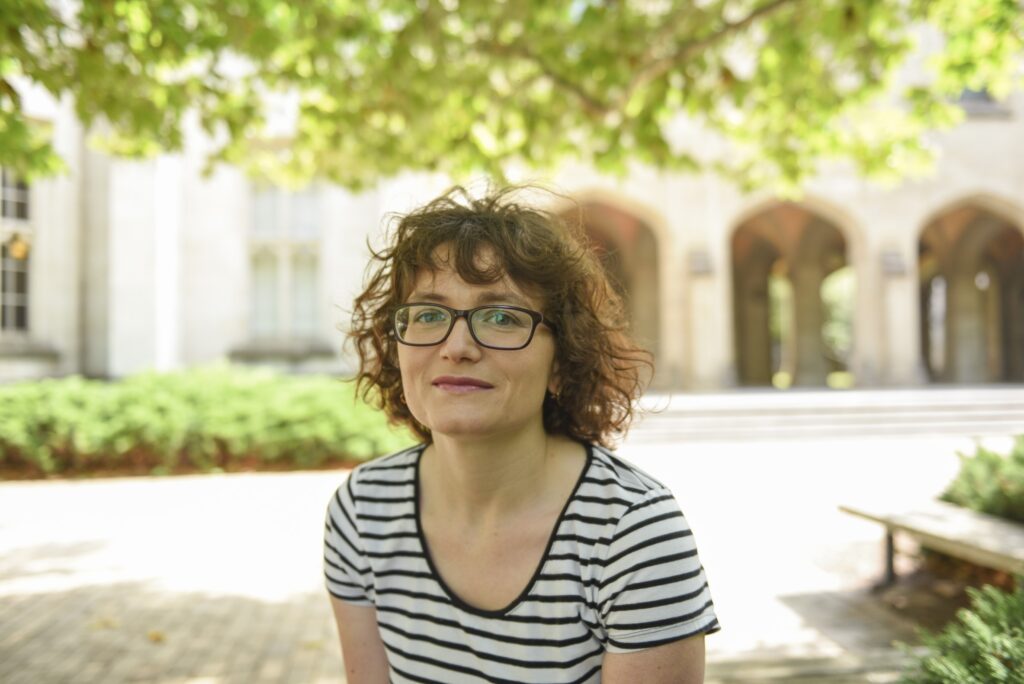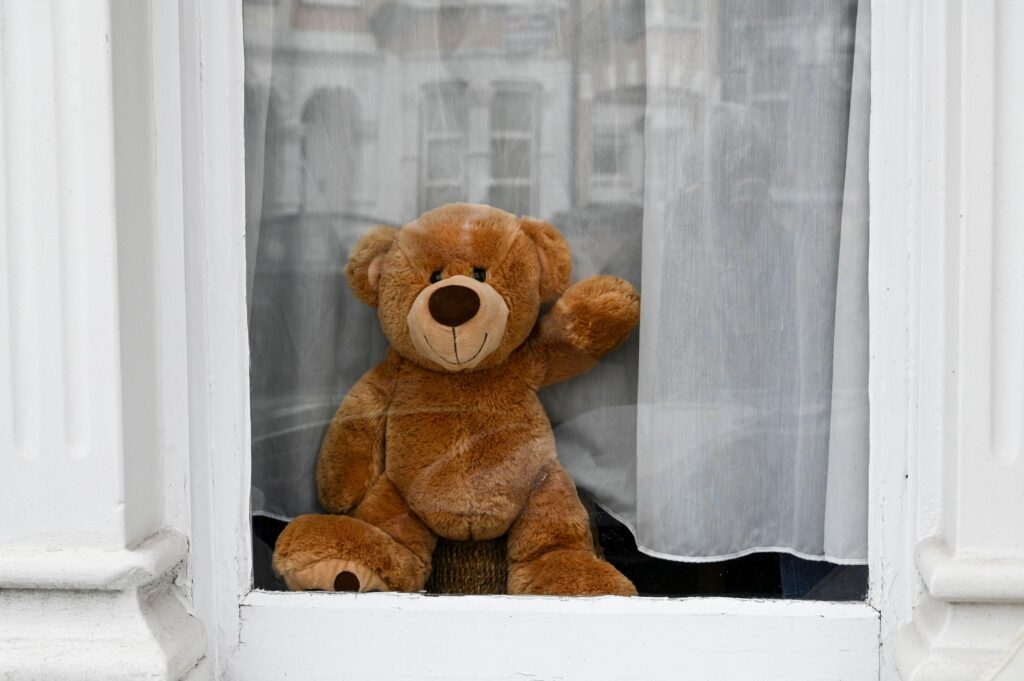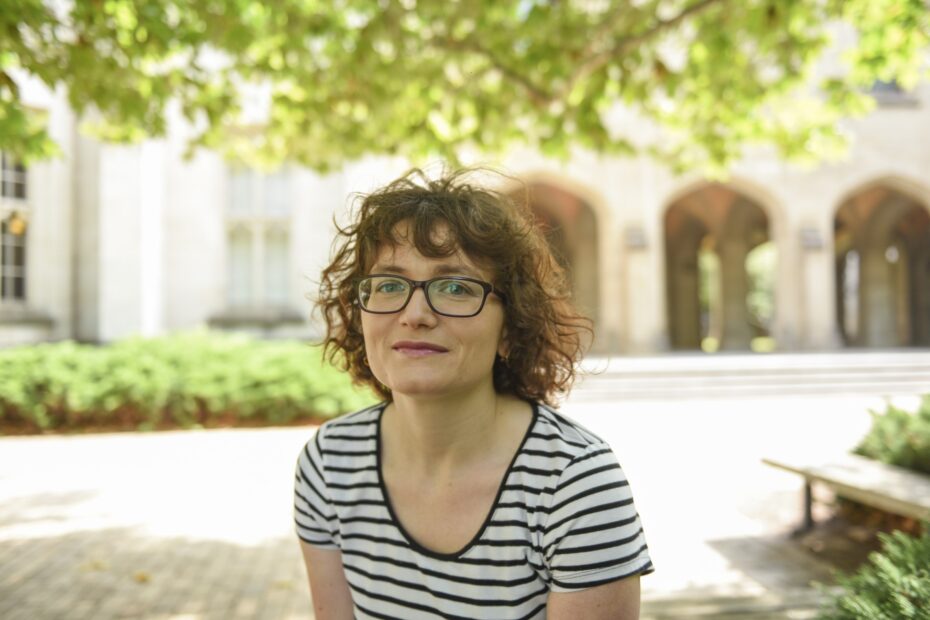Chloé Diskin-Holdaway is Senior Lecturer in Applied Linguistics in the School of Languages and Linguistics at the University of Melbourne. Her research expertise includes sociolinguistics, second language acquisition, discourse-pragmatic variation, language attitudes and ideologies, and discourse analysis. This is the first of our series of interviews with participants in the Getting Data working group, during which we talked about an exciting research project that Chloé has been involved during the pandemic, as well as how she and her colleagues adjusted to the new situation.

Can you tell me a little about the project that you’re currently working on?
The project is called ‘Bear in a Window’. It’s a completely online project inviting Australian children to share their experiences of living in lockdown during COVID-19. The name ‘Bear in a Window’ comes from a tradition that started about halfway through 2020 of people putting teddy bears in their windows, so that children who were out on their daily walk with their parents could say hello to the bears as they walked around their neighbourhood. There was a bit of an online following of the bears in the window. Some people started taking photographs of the different bears and sharing them on social media, so it became a bit of a meme. What we wanted to do in the project was to find a way for children to have a voice in a very important and unprecedented time in history. As linguists, as a team of linguists – there’s quite a lot of us in the project – we’re also interested in narrative development, the different stages that children go through as they acquire language and the ability to construct narratives. So, the project will have a couple of different outcomes. The first is to create a repository of recorded narratives by children and the second is to have something of a therapeutic effect, in the sense that it’s known that sharing stories and telling people about experiences can have a positive effect on people’s wellbeing. It’s known that children have been quite adversely affected by the pandemic, and especially the fact that they don’t go to school every day. Most children in Australia, depending on where they were in Australia, spent at least half of the year learning from home. So, I think that has had quite a big effect on them socially. The ‘Bear in a Window’ project is entirely online. We have a very simple website that explains a bit about the project. On the website, you can click on a link which takes you to an experimental platform called Gorilla, which is a platform that is typically used by, I think, mostly psychologists, but linguists have started to use it, too.
It goes back a little bit further than that. A team of us from a number of different universities in Melbourne and Sydney had a much bigger project, called AusKidTalk, that started in 2019, funded by the Australian Research Council, which was a large project designed to create a corpus of Australian child language. There is currently no Australian equivalent of the CHILDES Corpus. The project is part of a multidisciplinary effort involving engineers, speech scientists, linguistics, psychologists and speech pathologists. The original inspiration for the project was to collect a corpus of Australian children’s spoken language for machine learning purposes, for artificial intelligence, speech-to-text recognition, things like that. The corpus would help with educational games for kids, robotics, speech pathology applications as there were not enough samples of Australian child language to be able to train their models. So, they realized the potential of the project to be of interest to all sorts of people who work on language and child language, and they reached out to some linguists, speech pathologists, and sociolinguists like myself, and made it a broader team of people who would collect and create the corpus together at a number of different nodes and then use it for a number of different purposes. The AusKidTalk project has had a staggered start, because it was all set to launch in 2020 with on-campus data collection requiring a lot of equipment. Each node created a little child lab and set up apparatus that were child-friendly, so that we could then invite, depending on the node, two to five hundred kids to each campus to come and take part in a whole set of tasks that would collect a whole range of samples of speech. Some people were able, because they were in New South Wales which was less affected in 2020, to start data collection but some of us had to put it on pause because our campuses were completely shut down. And then we were all having these Zoom meetings and feeling a little bit depressed that our project might not get to begin for a very long time. So we started brainstorming about something else that we could do that was more related to the actual context, more related to what was happening, while at the same time getting us started with another child language project. And that’s how we came up with the idea of doing something that was totally online, that parents and children could do together and that would give children something fun to do while they were sitting at home bored.
What does the data collection look like and what kinds of data are you collecting?
When they visit the project website, children meet our mascot, Covey Bear, and they’re given a couple of instructions. They’re told to find a quiet space, and that they need to be on a laptop. The idea is that their parents help them with the first little bit, get them set up. They do a sound check and then they’re asked two questions. The first is ‘can you tell me something that was not so good about having to be at home all the time?’ and then ‘can you tell me something that was good about having to be at home all the time?’ There is a little timer that comes up; we give them 2 minutes. And if they want to extend, they can extend or they can keep going. The idea is that the whole experience shouldn’t take longer than 10 minutes from start to finish. So, it’s a pretty simple project, although it did take quite a bit of planning to get it all set up. At the beginning there is a standard plain language statement, and the parents give their consent. Then we collect a few demographic details. The child’s month and year of birth, the child’s gender, whether they were born in Australia, what their first language is, their ethnic or cultural background, the main language the child uses at home, whether they use other languages at home and their post code in Australia.
Do they speak into a microphone or do they type together with their parents?
They speak into the device’s microphone. This is one of the interesting challenges about doing data collection online during COVID-19 for linguists and speech scientists. For anyone working with speech, sound quality is really important. One of the things the team talked about at length was how we are going to deal with the different levels of quality that we’re going to get from people doing basically unsupervised research. And we agreed that the pros outweigh the cons here. If we’re going to start telling participants that they need to have special equipment, they’re not going to do it. One of the drawbacks of using Gorilla for doing recorded speech is that you can’t do it on a mobile. We couldn’t set it up to be mobile-friendly. So, you do need a laptop and that’s one of the things we deliberated over as well. Are people still going do it if they have to be on a laptop? But we figured, since kids were quite used to using laptops for home-schooling and since a lot of them were spending a lot of time at home and anyway, hopefully they wouldn’t be discouraged and would find the time to sit in front of a laptop for 10 minutes. We actually have a photograph of a kid sitting in front of a laptop, kind of saying ‘find a quiet space, sit in front of the laptop.’ And they do have to do a sound check. They have to see whether they can hear okay and then also they have to do a test recording, which is “hello Australia!”, and it gets played back to them. If they can hear what’s played back to them, they can continue.
And I suppose if you are analysing narrative and the construction of narrative, perhaps not focusing on phonetic data, then it may not be such a big issue.
Yes. Definitely from the point of view of narratives the sound quality is not going to be such a big issue as long as we can hear what’s being said. Depending on to what level of analysis we want to take the project and how long it goes on for, we should be able to use at least some of the data for other purposes as well such as sociophonetic analysis, you know, all kinds of different things if we have the corpus ready. But we figured at the very least we will be able to capture their stories and then the quality, even if it’s variable, should be alright. Also, built-in microphones on laptops are getting better and better, and one of our project members, a phonetician, also pivoted to doing completely online data collection for a different child language project during COVID-19. And she was having very good results on unsupervised data collection with built-in mics on laptops. So, it seems that the technology is getting better, and it may be less of an issue now than it might have been in the past.
Thinking about research during COVID more generally, what do you think, on the basis of you and your colleague’s experiences, has been the hardest part about dealing with the lockdown as sociolinguists or linguistic research in general?
There’s quite a lot of challenges, it’s hard to think of the one hardest thing. I guess it is a bit odd not meeting your participants, as I typically do face-to-face research and I really enjoy meeting participants. Especially when doing research with children, you’d like to be there to make them at ease and make it fun for them. It is quite a detached experience to unleash this experiment on the world and then you’re wondering to yourself how they’re finding it, how they are reacting. I’m sure there’s people out there who have been doing this kind of research well before the pandemic, and this is their modus operandi. But it was definitely something new for all of us. I just recently put in a grant application for a project starting in 2022. In that one, I proposed online data collection as well, but with a research assistant present. So, the person actually receives a Zoom call from the research assistant and is guided through the tasks. And the research assistant stays with them, because the tasks are a lot more complex and it takes longer. If that does come to fruition, I think it’ll be an interesting comparison as sort of a midway point between face-to-face data collection and completely online and unsupervised, so basically an online but supervised condition. From a feasibility perspective obviously it’s more expensive, because you have to use your time or someone else’s time to sit with the participants. But, on the other hand, I think it alleviates that sense of detachment and if the tasks are fairly complex, you probably get a better success rate in terms of completion.
This is a question that I’ve been thinking about since the start of this entire thing and I don’t have the answer yet. Before the pandemic, I wouldn’t have considered something like Skype a natural context for data collection. But now that is natural context, because it is how we conduct a big part of our conversations, and perhaps we are developing new types of conversations, new genres, new sociolinguistic events, if you will. So, what do you think about that? Is it just a different medium or is there something sociolinguistically significant happening?
Yeah, really interesting. I have been thinking about this. I think your use of the term ‘new sociolinguistic event’ is pretty much where I stand on the question as well. Speaking on a video chat, Zoom, Skype, WhatsApp, FaceTime, whatever, is different to a face-to-face conversation. You spend a lot of time looking at your own face, which is kind of a first. You’re dealing with the fact that only one person can speak at one time, which makes a group conversation very different. Normally, in group conversations, instances of overlapping speech are resolved in different ways. I think online it becomes more meta. You’ll get people saying ‘please, you speak’, or ‘there’s a delay.’ It almost seems like someone has to do a bit more management of the conversation. And then, obviously there’s different contexts. A work meeting Zoom is going to be different to a family catch-up on Zoom. But I agree that it is definitely the new normal. In sociolinguistics we do have this sort of primacy of the vernacular, or this almost yearning or nostalgia for naturalistic speech, whatever that is. And I think that speaking online to a video is naturalistic within its own context. We have children now who are growing up and speaking to the majority of their relatives not face-to-face but on a video chat, because they live too far away, because they are in lockdown, because it’s an easier way to keep in touch. So, I think even more so for kids than for our generation it’s very normal to interact with people on video chat. I’d be surprised if they think that it’s somewhat deficient; I think it’s just different.
There can be also other perhaps surprising advantages to online communication. One of my collaborators at Western Sydney University ran a project last year looking at heritage language maintenance in multilingual families, often of migrant backgrounds, looking specifically at the use of video chat during COVID-19 to stay in contact with extended family, normally grandparents. She found that COVID-19 actually created a really favourable environment for people to stay in touch with their relatives and that kids were actually very adept at communicating on video chat in their heritage language and it was really good for their heritage language maintenance. So, I suppose it does open up opportunities.

